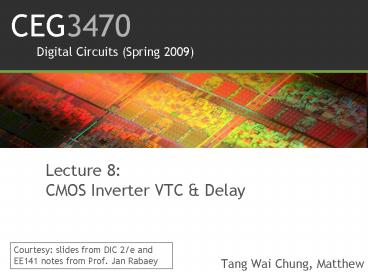Tang Wai Chung, Matthew - PowerPoint PPT Presentation
1 / 25
Title:
Tang Wai Chung, Matthew
Description:
For DC VTC, IDN = -IDP. Graphically, looking for intersections of NMOS and ... To put IV curses on the same plot, PMOS IV is 'flipped' since |VDSp| = VDD Vout ... – PowerPoint PPT presentation
Number of Views:148
Avg rating:3.0/5.0
Title: Tang Wai Chung, Matthew
1
CEG3470
Digital Circuits (Spring 2009)
Lecture 8 CMOS Inverter VTC Delay
Courtesy slides from DIC 2/e and EE141 notes
from Prof. Jan Rabaey
- Tang Wai Chung, Matthew
2
The CMOS Inverter
VDD
- VOH VDD
- VOL GND
- Ratioless ? min. size
- High input resistance
- Low output imped. (k?)
- No static power
S
G
IDP
Wp ?Wn
D
Vin
Vout
D
Wn
IDN
G
S
3
PMOS Load Lines
- For DC VTC, IDN -IDP
- Graphically, looking for intersections of NMOS
and PMOS IV characteristics - To put IV curses on the same plot, PMOS IV is
flipped since VDSp VDD Vout - Also, VGSp VDD Vin
4
CMOS Inverter Load Characteristics
5
CMOS Inverter VTC
saturation
resistive/linear
6
Switching Threshold as a Function of Transistor
Ratio Derivation
We assume both transistors are in velocity
saturation
where
7
Switching Threshold as a Function of Transistor
Ratio
- VM is relatively insensitive to variations in the
device ratio - r 3, 2.5, 2 yields VM of 1.22V and 1.18V and
1.13V - The changing of ratio shifts the transient region
of the VTC (consider a signal very noisy close to
GND)
8
Determining VIH and VIL
Simplified Approach
9
Gain as a Function of VDD
Reducing VDD does not affect the gain greatly,
until some threshold.
10
Impact of Sizing
11
Impact of Process Variations
12
Process Variations
- Not all transistors are alike
- Impacts parameters such as reliability and
performance
Define process corners SS, FF, SF, FS
13
MOS Transistor as a Switch
Discharging a capacitor
ID
C
VDD
Modeled this with
vout
R
C
vin
14
MOS Transistor as a Switch
- Real transistors arent exactly resistors
- Look more like current sources in saturation
- Two questions
- Which region of IV curve determines delay?
- How can that match up with RC model?
15
Transistor Discharing a Capacitor
- When a step input
ID
C
VDD
Transistor is in (velocity) saturation during
entire transition from VDD to VDD/2
16
Finding Req
Averaging the values of resistances at the
endpoints of the transition region and simplify
using Taylor series
Resistance is inversely proportional to (W/L)
ratio For VDDgtgtVT VDSAT/2, the resistance
virtually independent of supply. Once VDD reaches
VT, the resistance dramically increases.
17
The Transistor as a Switch
18
The Transistor as a Switch
Req (W/L1) in 0.25? m CMOS process
19
Inverter Capacitances
It is already complicated for an inverter.
20
Inverter Capacitance Model
- Capacitance models important for analysis and
intuition - But often need something simpler to work with
- Simpler model
- Lump together as effective linear capacitance to
ground - In most process Cg Cd 1.5 2 fFW(?m)
vin
vout
CL
21
Lumping the Caps
- Gate-Drain capacitances Cgd12
- M1 and M2 cut-off or in sat. during first half of
the transient. - Only overlapping cap. of M1 and M2
- Due to miller effect, Cgd 2GGD0W
- Diffusion capacitances Cdb1, Cdb2
- Quite non-linear and depends heavily on the
applied voltage. - Wire Capacitance Cw
- Gate Capacitance of Fanout Cg3 and Cg4
22
The Miller Effect
- During low-to-high or high-to-low transitions,
Vin increases, Vout drops - So, Cgd experiences voltage swing larger than Vin
- Which means you need to provide more charge
- Make Cgd look larger than it really is
- Known as the Miller Effect in the analog world.
23
Transient Response
tp 0.69 CL (ReqnReqp)/2
24
Delay as a Function of VDD
choose VDDgtgtVTn VDSATn/2, then
25
Design Techniques
How can we minimize the propagation delay of a
gate?
- Reduce CL
- reudce diffusion and interconnect cap.
- Increase the W/L ratio of the transistors
- The most powerful and effective performance
optimization tool. - Increase VDD
- This trade-pff energy dissipation for performance.































